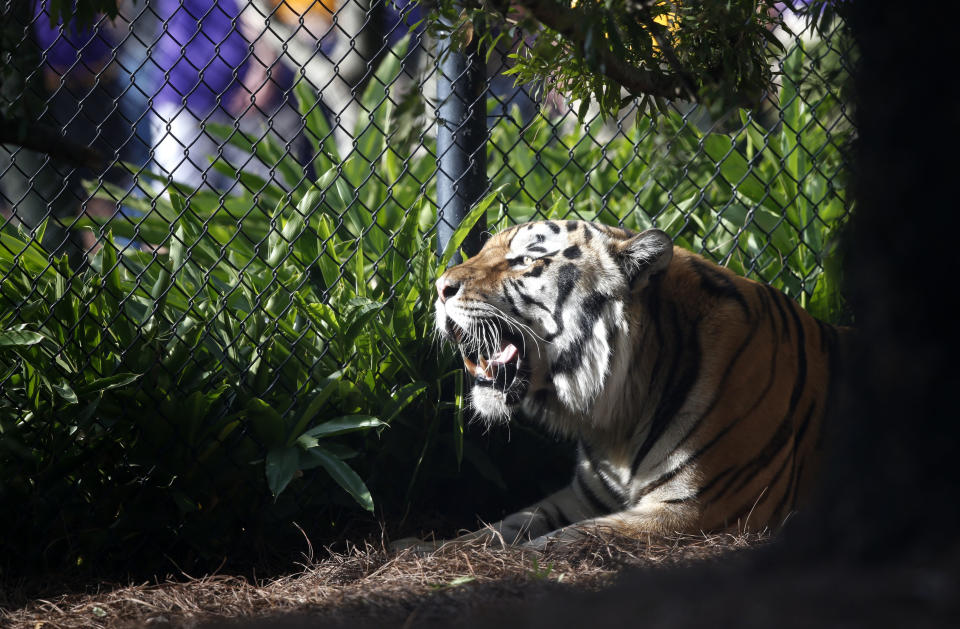LSU has found its new tiger mascot, and he's very cute (Updated)

Update: Monday, August 21 – 9:10 a.m. ET
It’s official: Harvey is now Mike VII. LSU announced Monday morning, the first day of fall semester, that the 11-month-old Siberian-Bengal male tiger that arrived on campus last week “officially began his reign” as LSU’s new mascot. He was deemed to be a good fit after being “quarantined and observed by LSU veterinarians to ensure that he was healthy.”
He's officially @MikeTheTiger, says Dr. Baker. He's out in his new habitat to start the @lsu semester! #LSU pic.twitter.com/w2zzyn2rQW
— LSU Tigers (@LSUsports) August 21, 2017
Welcome #MikeVII, who entered his habitat Monday as the official live mascot of @LSUsports! #LSU pic.twitter.com/kVnfrZKIHN
— LSU Pix (@LSUpix) August 21, 2017
Details on @MikeTheTiger entering his habitat, and the nearly $1 MM enhancement his home received: https://t.co/HItlt02vJ3 #LSU #MIkeVII pic.twitter.com/4xpbjkeox5
— LSU Tigers (@LSUsports) August 21, 2017
MikeVII has officially arrived on the first day of school….and he is incredible!!!! #MikeVII #LSUfamily #GeauxTigers pic.twitter.com/QR6bfVzC0D
— LSU Beach Volleyball (@LSUBeachVB) August 21, 2017
Original story: August 17 – 11:15 a.m. ET
It looks like LSU has found its new live tiger mascot.
Meet Harvey, everybody. He’s an 11-month-old tiger who is likely to be named Mike VII, and he’s very cool and cute.
Meet Harvey. This prospective tiger wanted to take part in Move-In Day too: https://t.co/fVOxXi6Ohx@MikeTheTiger #MikeVII pic.twitter.com/1zqGRflyUn
— LSU (@lsu) August 16, 2017
Harvey arrived on LSU’s campus on Tuesday, but university veterinarians have to observe how he reacts to the school’s tiger habitat before he can formally be named Mike VII. In a news release, LSU explained that the tiger’s health is top priority. If all goes well, Harvey will become Mike VII.
The tiger, “Harvey,” arrived on campus Aug. 15 and is currently being housed in the night house of the tiger habitat. The 11-month-old, male tiger must be quarantined in the night house for at least one week so that he can be observed by LSU veterinarians to ensure that he is healthy and a good fit for LSU. If that occurs, he will be formally introduced as the new mascot. Until that time, he is not Mike VII.
During the quarantine period, this rescue tiger will be acclimating to his new surroundings and will not be on view to the public or available for the media to photograph; his overall health must come first. Please note: Harvey is not Mike VII until he is formally introduced as the new mascot and released into his yard. If that occurs, LSU will notify the media and the public in advance.
[Now’s the time to sign up for Fantasy Football! Join for free]
Like Mikes IV, V and VI, Harvey was donated to LSU. This particular tiger came from a Florida-based sanctuary called “Wild at Heart Wildlife Center.” If he adapts positively to his new surroundings, he will replace Mike VI, who died in October after a bout with spindle cell sarcoma, a rare cancer. He was 11.
We are deeply saddened to have lost our beloved live Tiger mascot, @MikeTigerVI, after a 4-month battle with cancer. https://t.co/zSy3T7BCCY pic.twitter.com/RKF9mAdBip
— LSU Tigers (@LSUsports) October 11, 2016
Unlike with its previous live tiger mascots, LSU said last year that it will not bring Mike VII into Tiger Stadium for football games. Instead, Mike VII will remain in his habitat where fans can visit.
“Responsible care for live exotic animals has evolved throughout the years, and LSU has evolved with it, as evidenced by the renovations to the tiger habitat in 1981 and the construction of an entirely new habitat in 2004-05,” the school said. “In that vein, LSU has decided that the tiger will not go into Tiger Stadium on home football game days. He will be out in his yard seven days a week. By having Mike in his yard on game days, it ensures that fans are able to see him throughout the day.”
PODCAST: Pete Thamel on the Year of the QB
In July, LSU teamed up with three other schools with tiger mascots, Clemson, Auburn and Missouri, in an initiative to save tiger populations around the world. Of those four schools, LSU is the only with a live tiger mascot. Memphis also has a live tiger mascot, Tom III.
The effort was started by Clemson president James P. Clements, who serves on the Global Tiger Initiative Council, which has a goal of doubling the population of tigers in the wild over the next five years. In 2016, the tiger population was on the incline “for the first time in 100 years,” Clemson’s release said.
For more LSU news, visit TigerBait.com.
More college football from Yahoo Sports:
– – – – – – –
Sam Cooper is a writer for the Yahoo Sports blogs. Have a tip? Email him or follow him on Twitter!


